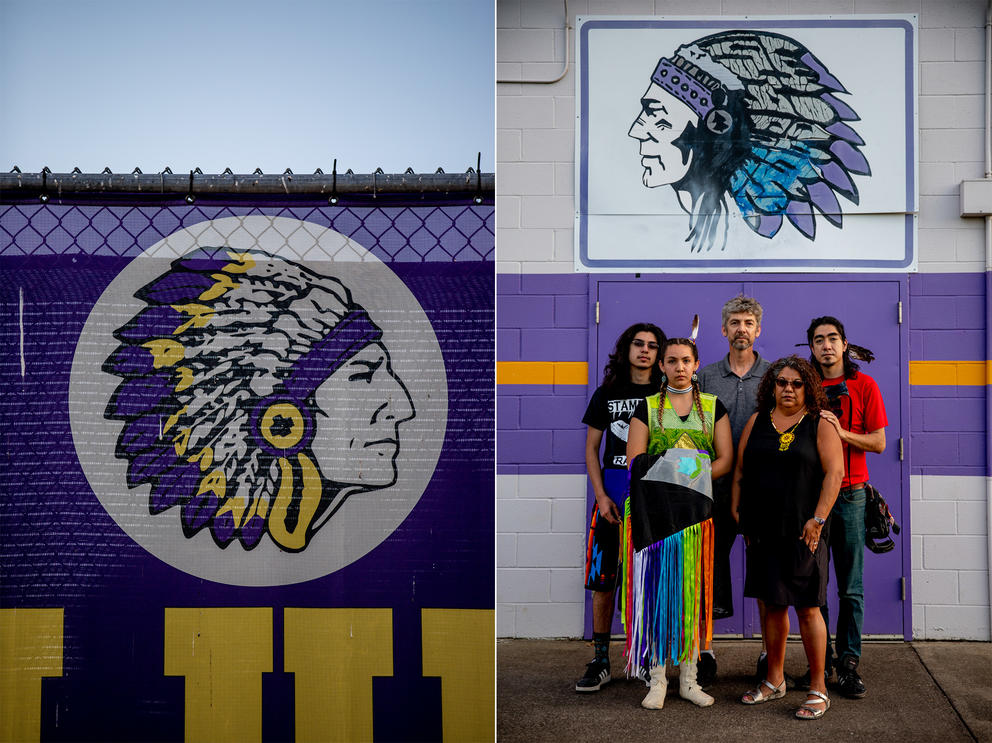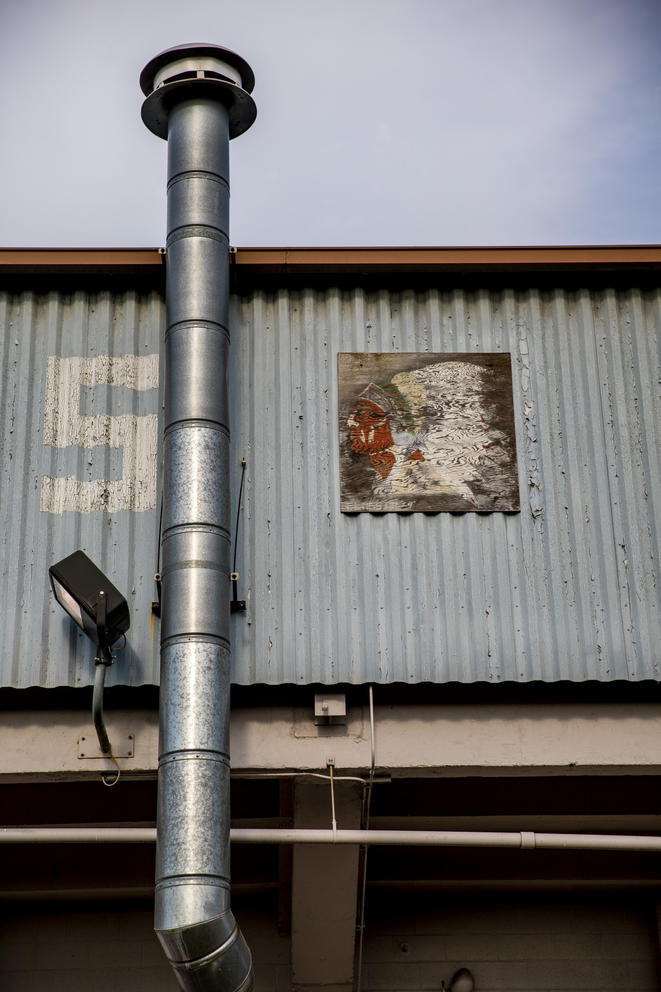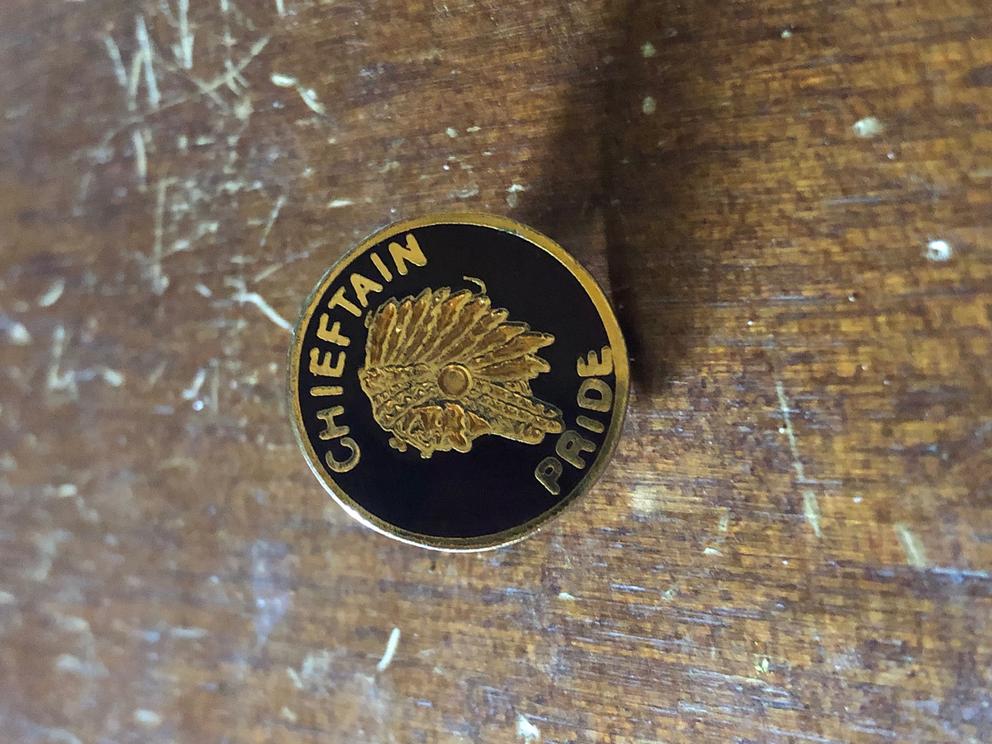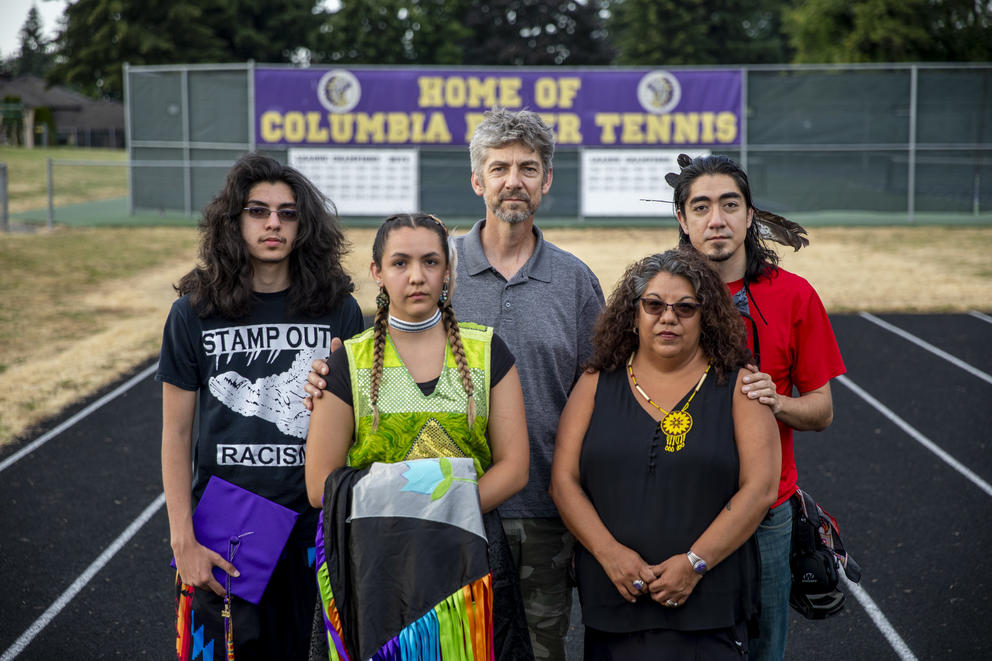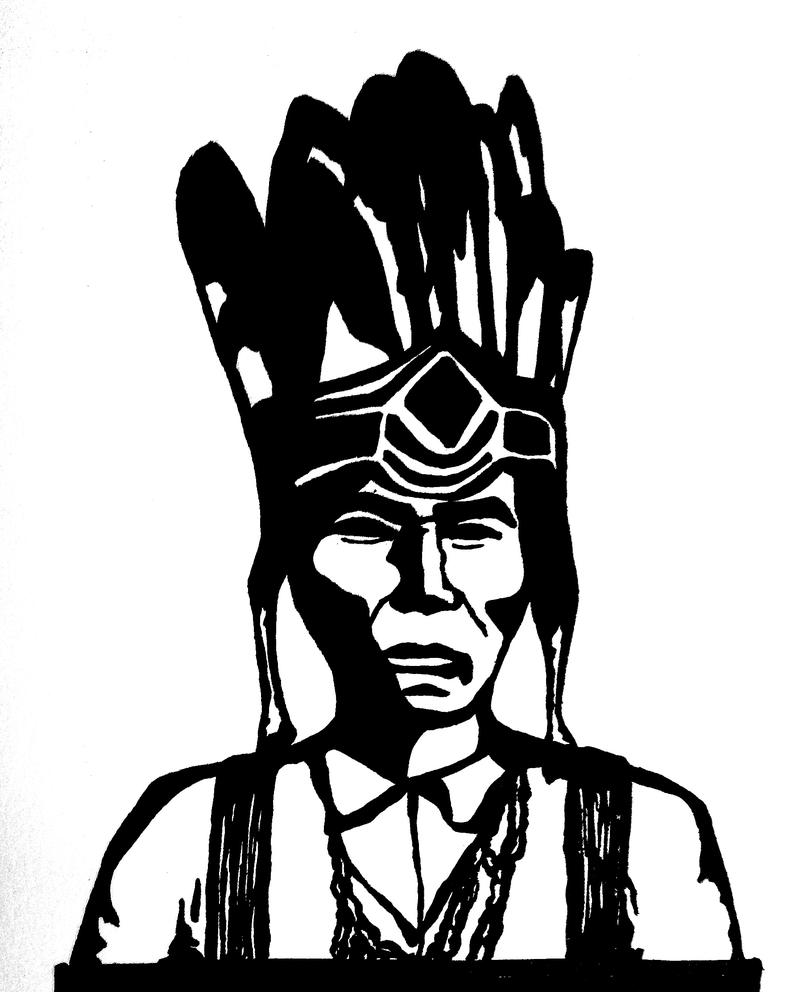As a basketball player at Columbia River High School herself, she would often glance over at the sidelines while playing and cringe. Cheerleaders would sometimes put two fingers behind their heads as part of their routines, pantomiming feathers. She can’t help but laugh a little when she remembers it.
“I saw that many times,” she says. “It was kind of embarrassing.”
Some traditions at the Vancouver high school, like the tomahawk chop, have since disappeared. The inspiration for these changes, however, remains in the school’s mascot: the “Chieftain.” It’s an illustrated profile of an Indigenous man with a feathered headdress that’s been the school’s symbol since the 1960s.
McAllister is Native on her mother’s side, who is Hopi, Blackfeet, Flathead and enrolled in the Confederated Tribes of the Colville Reservation as a member of its Entiat band. While students and administrators often defended the school mascot by explaining it was meant to honor Native people, McAllister couldn’t help but feel differently.
“It doesn't feel like they’re honoring anybody,” she says. “I know that some of them don’t have the right information and don’t know what it means.”
Native mascots of sports team litter American history. As long as they’ve existed, they’ve drawn ire from critics, often Indigenous, although it’s taken years for the movement against these mascots to gain traction. It wasn’t until this past July that the Washington, D.C., professional football team, infamous for its Native mascot (which for decades has been criticized as a racist caricature), conceded after the pressure of a recent campaign against it and agreed to change its name. The decision came in the wake of June protests against police brutality, an extra catalyst for Washington state teams to reassess the racial implications of their Native-related mascots as well.
At least a dozen Washington high schools still have Native sports team mascots. The Washington State Board of Education reported 50 teams were using Native-related names for their mascots — from “Braves” to “Indians” — when the board asked schools to reconsider that practice in 2012.
Each of Katherine’s three siblings, who all graduated from Columbia River High School, voiced their concerns about the "Chieftain" mascot to varying degrees while attending, but had little progress to show for it. The school is also where McAllister's parents met, and her mother, Stacey, remembers a similar discomfort with the mascot when she attended as one of few Native students at Columbia River decades ago.
Students and community members have campaigned against the mascot, starting polls or petitions against it over the past few decades. It’s become a familiar pattern: Criticism of the mascot heats up. The school may promise to improve or quietly cut back its presence in some ways. For example, the “Chieftain” symbol no longer graces the school's front or its website. But the mascot itself survives, unscathed.
The latest petition began circulating in June and has collected over 1,500 signatures. Katherine McAllister, 19, who graduated in 2019, wonders if this moment in history might provide enough of a push to make the change she’s waited for.
“It’s been an issue my whole life,” she says. “It’ll kind of be an issue for the rest of my life if it doesn’t get changed.”
The sinking feeling
The state board of education twice has spoken out about Native mascots in the past few decades, once in 1993 and a second time in 2012. It has asked that schools reevaluate their use, noting that some states, like Oregon in 2012, have banned these mascots.
Bill Kallappa II, an enrolled member of the Makah tribe who serves on the state board, says that these mascots do more than mischaracterize Native people. He says studies have revealed their harmful psychological impacts on Native kids, often contributing to hostile school environments and adverse mental health effects. Even so, Kallappa says the board can’t force schools to change their mascots. Those decisions happen on a local level.
Wendy Smith, president of the Vancouver School Board, says students at schools in the area typically take the lead in picking out mascots. The board, however, does have the final say; it can decide what will and won’t be a school’s mascot, although this isn’t a decision Smith has had to make while working on the board. Columbia River’s mascot is a peculiar case, she says, since it was chosen by students when it was approved in the 1960s.
“I’m not sure that, given today’s climate, that the board would have approved ‘Chieftains’ as a school mascot today,” she says. “It was a different time.”
Stacey Nasewytewa-McAllister, Katherine’s mother, grew up on the Warm Springs Indian Reservation in Oregon. Moving to Vancouver, Washington, and later attending Columbia River in the 1980s were both big shifts in her life. Suddenly, she was in a white, urban space, where many of her peers weren’t aware she was Native at all. If someone asked, she’d tell them — but her heritage wasn’t something she broadcasted.
She didn’t think much of the mascot at first, but a pit in her stomach, an uneasy nausea, deepened over time. At school assemblies and football games, where she saw cheerleaders dance with headdresses to the marching band’s drumbeat, she felt sick to her stomach. Her friends treated it as a joke and no one she knew challenged it. So, most of the time, she stayed silent.
“I had a sinking feeling, but I didn’t know what it was,” she says. “I was still so painfully shy. I didn’t know you could fight for things like that.”
Smith, the Vancouver board president, attended the school herself in the 1990s, and she remembers students dancing in “Indian” costumes at football games and a cartoonish mural of a Native person displayed on the campus. Those both disappeared after a student survey concerning the mascot was taken during her time there, similar to recent attempts to change it.
“So there were some of those practices that were eliminated, although the mascot stayed the same,” Smith says.
Years later, Nasewytewa-McAllister would drive her own kids to the school. Once, she remembers picking up her eldest son, Curtis, when he told her to pull up to the school football stadium. There, on the field, was a teepee.
Her son told her that the janitor had discovered it somewhere at the school and put it up. She later learned that a parent apparently thought it might be a good idea for cheerleaders to come running out of it during the next football game.
“That was considered someone’s home,” she says. “You just don’t do that.”
She was not going to let that happen. Nasewytewa-McAllister quickly called up the school principal and told him that the teepee didn’t need to come down — she could educate students about its significance. But she was told that students weren’t interested, and there wasn’t enough time for that.
That was particularly frustrating, she says: “You can have a pep assembly and do the tomahawk chop, but you don’t have time to teach them about it?”
Soon after, at least, the teepee was gone.
‘A nightmarish dream’
For Native students, the atmosphere that the mascot inspires is at turns laughable and surreal. It’s a mixed feeling that Anastasia McAllister, Katherine’s older sister, knew well: Seeing white students participate in Chieftains-inspired traditions felt like seeing her family’s culture through a funhouse mirror.
“It just feels like a dream, like a nightmarish dream, to see that,” she says. “At home, I don’t question or think about my identity — I’m just Native. But then I walk into school and I’m confronted with the fact that … this is what people think of when I say, ‘I’m Native,’ everything going on at that school, and it’s completely inaccurate.”
Anastasia, now 25, went to Columbia River after her brother, Curtis, and made the mascot her daily fight. She remembers a huge “Chieftain” head on the carpet by the school’s entrance. Some students avoided stepping on it — typical school mysticism, she says, which dictated that doing so was unlucky. So she took it upon herself to step on it every day.
That was only the beginning. Throughout her years there, she criticized the mascot whenever possible. When school administrators erected a display of old school memorabilia, including costume headdresses, she demanded it be taken down. At her graduation in 2013, she was told she wasn’t allowed to put an eagle feather in her cap, which is a Native tradition — so she hid one in her sleeve and stuck it in while receiving her diploma.
“I really thought I was going to make a difference while I was there,” she says. “But that’s just too much to put on a kid.”
But, like others before her, she tried.
In conversations with students at the school, she found resistance to the idea of changing the mascot from a “Chieftain” to something else. Fine, she thought — it wasn’t her preference, but she could work with that.
In her senior year, Anastasia studied the history of Native people in the area and spoke with local tribal elders about the mascot, using what she learned to draw up a historically accurate version of the “Chieftain.” One common critique of the current mascot is that the headdress in the illustration is similar to what a Plains Indian might wear, and not at all what a Native person in Washington would. To avoid that, she modeled her illustration after a real person, Chief George Charley of the Chehalis and Shoalwater Bay Tribes, whose community overlapped with the Vancouver area.
It wasn’t enough. While the school lauded her work, using her illustration in some pamphlets that year, it was shot down as a permanent alternative. Anastasia heard from some alumni that they preferred the original, as inaccurate as she found it be.
“Americans really like that Plains ‘Chieftain’ logo, and we see that everywhere,” she says. “They don’t want to see anything accurate; they just want to see the romanticized depiction.”
She adds: “If they see a Native image from today … that’s real and accurate, and it makes them question their reality. That’s when there’s pushback. Then the Columbia River Chieftain isn’t fun anymore — it’s not tomahawks, it’s not war hoops and chanting, it’s reality.”
Katherine McAllister, taking after her sister, spoke with the school principal about the mascot her freshman year. But she was simply directed to the school’s Social Justice and Awareness Club. At the time, she felt too discouraged to press the issue further. Later, during her final year, the club managed to bring the issue up to the Vancouver School Board. Students in the group had spoken with local tribes and Native graduates of the school about the mascot and its future in preparation.
Smith, who heard the students’ arguments, says the board also reached out to some tribes in the area, including the Confederated Tribes of Siletz Indians and the Cowlitz Indian Tribe. Representatives from each differed in their approach to the issue. Some wanted a wholesale change, while others wanted the mascot kept but tweaked for accuracy, emphasizing better Native history education. Regardless of their responses, each agreed that something should change.
The club’s efforts led to a poll in May 2019 that asked students whether they supported changing the mascot. The result was overwhelming: 79% voted to keep it. This didn’t come as a surprise to Dakota Anderberg, a member of the Saddle Lake Cree Nation and one of the Native alumni that students in the Social Justice and Awareness Club spoke to before the poll. Many people aren’t taught about the diversity of Native communities, she says. That would have helped students to understand why this image seems to lump those communities together under an image that’s often comfortably familiar for white students.
“It discounts so much,” she says of the mascot. “It’s really just another form of genocide in that way, because so many nations are being erased in one image.”
Retelling history
The most recent petition to replace Columbia River’s mascot, written by an anonymous alumnus, sent ripples throughout the broader Vancouver community. It circulated in early summer among students, community members and teachers. And as before, alumni and others surfaced with equal force to defend the mascot.
It’s obvious to Smith that the issue reaches beyond the high school. Given the persistence of recent conversations about the mascot, she’s interested in the board taking a more active role in its future and talking to local tribal representatives in person, rather than through written communications, as they have before.
“We probably should have handled it more expansively in the sense that it’s not just a Columbia River community issue,” she says. “The larger community of Vancouver public schools is invested in this as well.”
Katherine McAllister says she’s not personally against the idea of having a Native person as the school mascot. Native mascots have been associated with both tribal and nontribal schools alike, adding that it’s impossible to get a consensus among Native people on the “right” approach to this issue.
When she looks at Columbia River’s mascot, at least, she doesn’t see anyone she recognizes. The difference for her between tribal and nontribal school depictions often boils down to how they were created. Schools that do it right, in her eyes, often know the tribal community they’re portraying and will show them accurately. Her school’s mascot aligns more with what non-Native people think of her community than what it really looks like.
“There are Native schools named after Native Americans,” she says. “But the people going there are actually Native Americans, and they understand that background and their own culture. To have a white-majority school with a mascot that’s stereotyped is the issue.”
For Katherine McAllister, education is key. Hopeful as she may be about the most recent petition, she says that, at the end of the day, switching out the mascot alone would be an aesthetic improvement. It’ll ring hollow if students never understand why it happened.
“I don’t think there’s been enough education,” she says. “They should be taught what land they’re living on, what land that they’ve been walking on their whole life and who came before them.”

